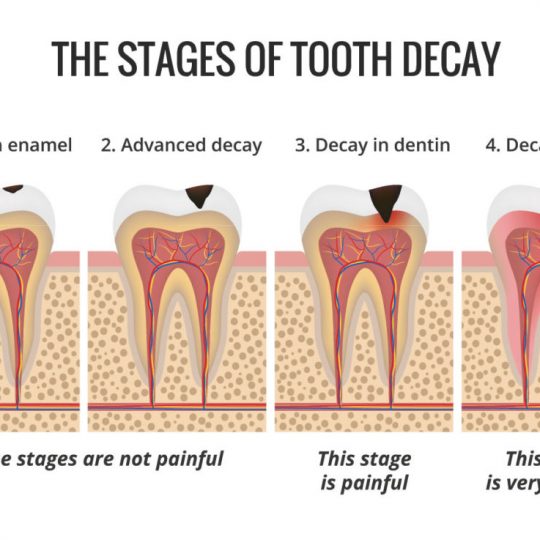
Tooth Decay
Tooth decay is also known as dental caries or cavities.
Anatomy of a tooth:
A tooth has outer Enamel followed by Dentin and Pulp, Cementum covers the root portion.
The Enamel is the hardest structure of the tooth.
The Dentin has the sensory nerve endings.
The Pulp is the innermost part which contains the blood vessels and nerves.
How tooth decay occurs:
Bacteria causes the breakdown of the hard tissues of the tooth, the enamel, dentin or the cementum. For tooth decay to occur there should be three factors which include, Bacteria, tooth and time. The acid produced by the interaction of bacteria and food causes demineralization of the tooth.

How do you know you have a cavity?
The early stages of tooth decay do not have any symptoms. The earliest carious lesions appear as a white chalky spot, which turns to brown and later on to black. When the cavity turns black there will be a definite cavity. By this time the cavity may be a little sensitive and if ignored further might result in constant pain that is not reversible.
Signs and Symptoms:
- White, brown or black spot on tooth
- Tooth may be soft.
- Tooth may be sensitive to hot, cold or sweets.
- Pain which can be momentary or sometimes prolonged.
- Sudden fracture of tooth due to internal decay.
- Foul taste in mouth.
- Pain while chewing which can be sharp, acute or dull and throbbing.
How to prevent tooth decay:
- Brush twice a day – Brush your teeth at least twice a day with the proper brushing technique. Give enough time for brushing both the inside and outside of the tooth surfaces. Two minutes is the minimum time you should devote to brushing. Using a toothpaste that contains fluoride is helpful in the prevention of cavities as it hardens the enamel.
- Floss – Floss at least once a day preferably before going to bed. Flossing dislodges any food debris stuck between the teeth where the toothbrush cannot reach.
- Rinse – After eating it is helpful to rinse with water to clean the mouth when a toothbrush is not available.
- Eat Healthy – Eating healthy food such as fruits and vegetables. The food rich in fiber cleanses the teeth and also increase saliva which keep the mouth clean. Food like chocolate, candies and chips can remain in the grooves and pits on the teeth and cause decay. Also avoid sugary liquids like pop which can weaken the tooth enamel.
- Frequency of eating – Every time you eat the reaction between the bacteria and food causes acid, making it more likely to get a cavity.
- Dental Sealants- Some teeth have deeper grooves and pits than normal. These regions act as retentive spots for food and are highly prone for cavities. Dentists then decide to put sealants, a liquid which flows into these grooves and hardens to prevent cavities.
- Fluoride Treatments – Dentists might recommend some professional fluoride application in those people who have higher tendency to develop cavities.
- Visit your Dentist regularly – Regular dental check-ups and cleanings are important in detecting and preventing early caries.
